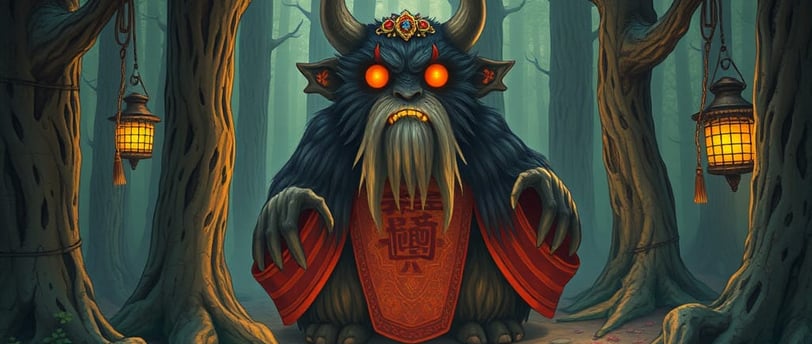Kodama – Guardians of the Forest
The Kodama, spirits of the forest, have long held a revered place in Japanese folklore.
FOLKLORE & FABLES
1/22/20252 min read


The Kodama, spirits of the forest, have long held a revered place in Japanese folklore. These ethereal beings are believed to inhabit ancient trees, acting as protectors of the natural world. Their origins, manifestations, and influence span centuries, intertwining myth, culture, and environmental awareness.
The Origins of Kodama
The concept of Kodama finds its roots in Shinto beliefs, where nature is imbued with spirits or kami. Kodama are thought to be the spirits of particularly old or significant trees, marking them as sacred. These trees, often centuries old, are seen as the homes of the Kodama, and their presence is signified by an aura of mystery or even a faint glow. The idea of Kodama likely arose as a way to explain the uncanny stillness and presence felt in ancient forests, as well as to instill a sense of respect and caution when dealing with nature.
Manifestations and Variations
Kodama have been depicted in various ways throughout history. In traditional folklore, they are invisible entities, only revealing their presence through sounds, such as an echo or a strange rustling in the woods. Some tales describe them as small, humanoid figures with glowing features, while others portray them as amorphous, ghost-like forms.
One of the most famous modern interpretations of Kodama comes from Hayao Miyazaki’s animated film Princess Mononoke. In the film, Kodama are depicted as small, white, doll-like spirits with rattling heads, representing the health and vitality of the forest. This portrayal has become iconic, bringing Kodama to a global audience and cementing their place in popular culture.
Kodama in Historical Context
In ancient Japan, the belief in Kodama influenced how people interacted with their environment. Trees believed to house Kodama were often marked with sacred ropes called shimenawa to signify their importance. Cutting down such a tree was considered a grave offense, believed to bring misfortune or even death. These practices reflect the deep respect for nature embedded in Shinto traditions.
During the Edo period (1603–1868), Kodama became a popular subject in literature and art. Poets and painters often used them as symbols of nature’s beauty and mystery, emphasizing humanity’s fragile relationship with the natural world.
Kodama in Modern Times
Today, Kodama remain a powerful symbol of environmental stewardship. Their association with the protection of forests resonates strongly in an era of climate change and deforestation. Modern interpretations, such as their depiction in Princess Mononoke, highlight the delicate balance between human activity and ecological preservation.
Kodama also inspire contemporary art, literature, and even conservation efforts. Forest preservation campaigns in Japan and beyond often invoke the imagery of Kodama to emphasize the spiritual and cultural significance of trees.
Lessons from the Kodama
The legend of Kodama teaches us to respect and protect the natural world. These spirits remind us that nature is not merely a resource to exploit but a living entity deserving of care and reverence. In the face of environmental challenges, the Kodama’s message is more relevant than ever.
Whether as mythological beings, cultural icons, or environmental symbols, Kodama continue to captivate and inspire. Their story bridges the ancient and the modern, urging us to honor the forests that sustain life and to listen closely to the whispers of the trees, where the Kodama may still dwell.
Did you like this article?
Thank you for your support!
Every donation helps us create more engaging content, improve the quality of our stories, and dive deeper into the fascinating worlds of ancient legends, historical mysteries, and folklore. Your contribution fuels our creativity and allows us to share these captivating tales with a wider audience.
Together, we can bring these myths and stories to life! 🙏✨
© 2025. All rights reserved.
You may notice "Buy Me a Coffee" links throughout this site. These links allow readers to support our work and help us maintain this platform. By relying on contributions from our audience, we aim to avoid intrusive advertisements, ensuring a cleaner and more enjoyable reading experience for you.
Your support keeps our site ad-free and helps us continue sharing stories, mysteries, and insights without distractions. Thank you for being part of our journey!
